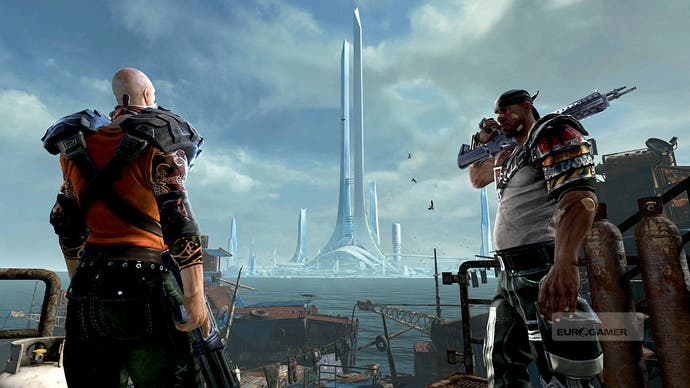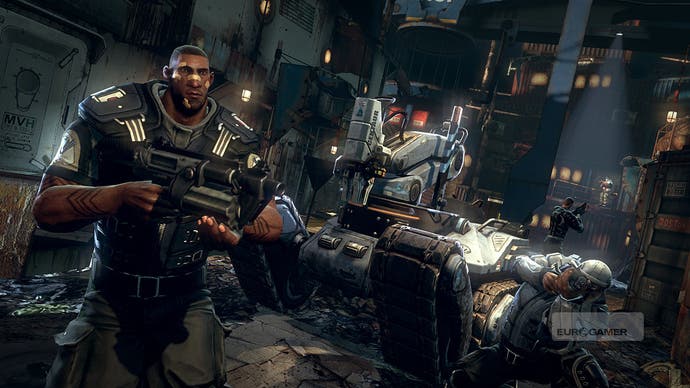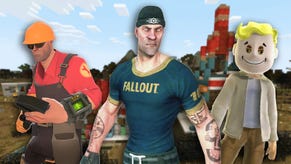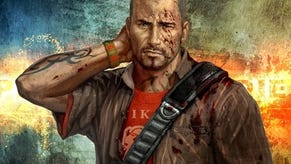Brink
When is an online shooter not an online shooter?
"Splash Damage obviously comes from a PC hardcore FPS background, so it's been kind of weird for us to hear people go, 'wow, four-player co-op is kind of cool'. We know! We've been trying to tell you! But four-player co-op is not enough, so this is eight-player co-op. We think in terms of solo, co-op and competitive, rather than single- and multiplayer."
What's interesting is that Splash Damage's ambitions in Brink have been entirely focused on this kind of flexibility, rather than scale. Player numbers are restricted to two teams of eight, which might seem like small beer compared to the multiplayer modes of many mainstream shooters, never mind the dedicated likes of the Battlefield series, Sony and Zipper Interactive's extraordinary 256-player MAG, and even Splash Damage's own work.
"Sometimes we had enormous servers and you just never lived very long... it's about just what gives the most players most fun most of the time," says Stern. "The sweet spot for us is absolutely eight-v-eight. We'd rather have closer engagements. For example, we don't have any really hardcore sniping in this game. There is a more accurate rifle that fires a bit slower, but the whole sniper alley thing just isn't enough fun for enough players."
"I tend to think of this game as the shooter that will convince people who don't like multiplayer shooters that, yeah, you do, if it's done right," adds Ham, revealing that he was previously one of those people. "I'm really the target audience. I love Call of Duty, I've loved them all - even the Treyarch ones. But I've always finished the story campaign and then just walked away. I would never go online because it's really just a cesspit of the foulest of humanity."
Back to the demo, and the map is, unusually for a multiplayer game, introduced with a short scene-setting cinematic and some banter between the Security team-members. Ham reveals that storytelling is being limited to 30-second bursts like this one, long enough to add colour and context for the solo player, short enough that it can simply act as background for the usual pre-match countdown and setup-fiddling in multiplayer matches.

Then we're introduced to Brink's secret weapon: the mission wheel. This is a selection of automatically-generated and ranked optional objectives, available from the d-pad. The top one, selected with a tap on up, always rewards the most experience and is dynamically picked by the game to suggest what will be the most useful - and the most fun - for everybody concerned.
"If you just press up, you'll get given the most useful thing you can do, either do an objective yourself, or help the guy who's doing it. If there's no-one of that class, we'll give you an XP bonus for switching to that class," says Stern. "Richard's got a great phrase for it - the game doesn't tell you how to play the game. It's like having someone who knows the game over your shoulder, just offering advice. We're not going to make players play a particular way. We're just going to say, actually it would be pretty useful if you did this, but go for your life."
"And if you ever find yourself in a situation that you're always being completely owned - that's something that we definitely want to recognise, that you're not having fun," says Ham. "We're going to take care of that. Your team-mates will get objectives to actually give you more bonuses than they would be able to normally. The enemy will get objectives to assassinate the guy who's bringing the game down for everybody."
It's a similar system to one in MAG, but where Zipper's game focuses on player-command and only steps in when there's a power vacuum, Brink takes a more active role in shaping the flow of play while offering more choices to the player at any one time. This apparently simple menu is the heart of Brink, modulating the game according to player numbers, behaviour, composition and balance, and offering enough freedom that, hopefully, no map or story segment will play the same way twice.

It's an interesting system, and it's at least got the potential to fulfil Stern's lofty dream of creating a game that's "a completely consistent gameplay experience whether you're doing it solo and offline or co-op and online". A more pressing question for Brink is whether the content itself, these loose agglomerations of missions, can live up to the expectations of players weaned on the obsessively-crafted single-player set-pieces of a Modern Warfare.
Left 4 Dead managed that through its ruthless simplicity and cunning enemy designs. Brink's combat certainly appears meaty enough, but some of the objectives seem like weak sauce: a crude "interrogation" (zapping a lifeless NPC with a taser for 10 seconds), lots of pressing buttons on terminals, setting charges and operating cranes. In isolation, they don't thrill, but it will be how they play off each other in co-op and competitive matches that provides the real interest. We still have our doubts that Brink won't feel like an empty shell played solo; that also depends on whether Splash Damage's claims for its AI bots ("good, competitive, helpful team-mates") stand up to scrutiny.
Nevertheless, and despite its rather generic setting, Brink is a striking game and a firm step for both Splash Damage and Bethesda out of their respective comfort-zones. As online gaming continues its cautious creep on consoles from menu option to underlying philosophy, it could well be hybrids like Brink that lead the way.
Brink is due out for PC, PS3 and Xbox 360 in spring 2010.








